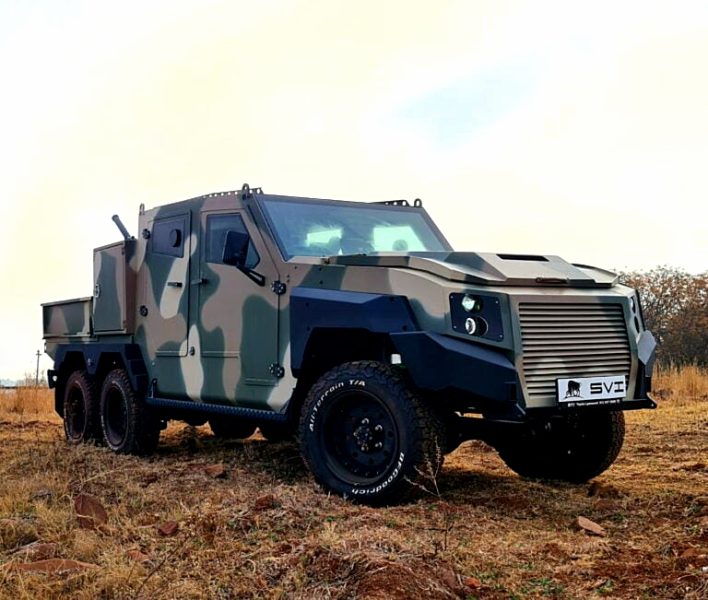An African nation has initiated the first order for SVI’s all-new six-wheeled MAX 3 armored vehicle, marking the commencement of what SVI is confident will be the first of numerous forthcoming contracts.
These vehicles, intended for non-military applications as general cargo carriers, have just begun production at SVI’s factory east of Pretoria. The manufacturing process is scheduled for completion by February of next year.
SVI’s CEO, Jaco de Kock, sees this order as a promising start for the six-wheeled variant, believing it will significantly pave the way for more customers to follow suit. DefenceWeb reports.
The six-wheeled version of the popular 4×4 MAX 3 was publicly unveiled at the September 2022 Africa Aerospace and Defence (AAD) exhibition held in Pretoria. It’s built upon Toyota’s well-proven Land Cruiser 79 chassis, much like the 4×4 MAX 3. Both versions are powered by a 4.5-liter V8 turbodiesel powertrain, enabling them to reach a top speed of 140 km/h. The six-wheel model is based on the MAX 3 double cab body style and can also be fitted on the MAX 3 single cab and MAX 3 Troopy armored personnel carrier.
The addition of a third axle enables the MAX 3’s Gross Vehicle Mass (GVM) to be safely increased to 5,500 kg, up from 3,800 kg. This expansion opens up various military and security applications, including the attachment of different weapon systems, cargo-carrying setups, and even field ambulance configurations. The total payload capacity is now 1,500 kg.
To manage costs and minimize complexity, the additional axle on the six-wheeler is non-driven. Nevertheless, it enhances mobility as the extra axle provides improved flotation on soft terrains. The six-wheel MAX 3 exhibits excellent off-road performance, effortlessly navigating axle twisters, rocks, and other obstacles. Surprisingly, despite its added length, it handles similarly to the 4×4 MAX 3, thanks to familiar controls, ergonomics, and visibility, akin to an unmodified Toyota.
Despite weighing approximately four tons, the six-wheel MAX 3 feels neither heavy nor sluggish. The V8 diesel engine provides ample power and brisk acceleration, even when loaded or equipped with additional equipment such as the Scorpion mortar on the back. On paved roads, it swiftly reaches the legal cruising speed of 120 km/h, with plenty of power to spare.
SVI is considering the production of a 6×6 version with all six wheels being fully powered, although this would naturally entail higher manufacturing costs.
The conversion process to create a MAX 3 involves replacing the soft-skin body of the donor Land Cruiser 79 with a specially designed armored steel plate hull. This configuration offers a minimum protection level of EN1063 BR6 against assault rifles, with options for upgrading to BR7 protection.
SVI can produce various MAX 3 configurations tailored to customers’ needs, including ambulance and weapons carrier versions. At the Africa Aerospace and Defence exhibition, one six-wheeled MAX 3 was equipped with a counter-drone system, while another at SVI’s factory featured a Thales Scorpion remotely operated mortar.
SVI’s Business Development Director, Nicol Louw, revealed that production of the 4×4 MAX 3 is proceeding steadily, with approximately one vehicle manufactured each week. A significant selling point is its cost-effectiveness compared to a Land Cruiser 300.
One recent MAX 3 customer is the Mossel Bay Municipality, which acquired two for tasks such as riot control. The municipality sought a smaller, more agile vehicle for urban operations than the police Nyala, enabling operation in tight urban areas. These Mossel Bay MAX 3s are equipped with scrapers for obstacle clearance, such as on blocked highways. Following Mossel Bay’s order, other municipalities have expressed interest in obtaining the vehicle.
The majority of MAX 3 customers are security and mining companies, with substantial demand from the mining sector. SVI is projecting sales of around 30 MAX 3 vehicles for this year alone. The MAX 3 is suitable for non-military applications like mining security, riot control, civil security, anti-poaching operations, and convoy protection for transporting valuables.
The original MAX 3 was unveiled at the September 2018 Africa Aerospace and Defence exhibition. It can be fitted with various additional equipment, including the Thales Scorpion 60/81 mm automated mortar, a 12.7 mm pintle mount, or a 12.7 mm Rogue Lite remotely operated weapon station. One customer has already placed an order for the Scorpion system. Other available options encompass fire extinguishing systems, long-range acoustic devices for crowd control, and less-lethal solutions.
As a specialized vehicle armor manufacturer, SVI has experienced rapid growth in recent years, with its production facilities outside Pretoria operating at full capacity. In response to soaring demand from the commercial, defense, and security sectors, SVI is adding two new production buildings to its Pretoria premises, measuring 600 and 750 square meters, respectively, while expanding its workforce to over 100 employees. The company aims to manufacture 200 vehicles this year.
Last year, SVI announced that it has expanded into Saudi Arabia, where it plans to develop and manufacture a variety of armoured vehicles and military solutions.
Notably, SVI doesn’t exclusively sell its vehicles; it also maintains a fleet of over 30 armored vehicles for rental, including some MAX 3 vehicles. Many of these are rented out for significant events, with the rental fleet enjoying high utilization rates.
In conjunction with the growth in armored vehicle sales, SVI operates a dedicated academy alongside its Pretoria East factory, offering driver training solutions. SVI’s academy is the only one in South Africa to provide SASSETA certified specialized training on armored vehicles, focusing on defensive driving skills like night driving, off-road driving, convoy driving, and more—areas where armored vehicle drivers are most likely to face challenges. The five-day course also covers obstacle clearance, tactical deployment, legal aspects, high-speed driving, and more.
The driver training academy has been successful, with many trainees acquiring specialized skills for embassy-related roles.
